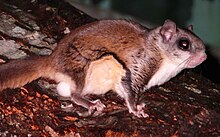Normally, at this time of the year we are getting a lot of calls for mouse problems, but this year there doesn't seem to be that many of them. HOWEVER, what seems to be literally coming out of the woodwork are flying squirrels. These are adorable little critters which seem to be in everyone's attic this year. Some are getting down into the living area of homes, where I have spent much time chasing them around before being caught and relocated.
These little critters are about the size of a chipmunk and have a large flap of skin between their front and hind legs. When they jump off a roof or tree limb they put their legs out and become little gliders. The fur on their tail is flattened top to bottom and this is used as a rudder to steer when they are airborne, and as an air brake when they are about to land. Unlike other species of squirrels (gray and red) which are seen hopping around during the day, flying squirrels are nocturnal. The are out at night. They can be quite noisy when they leave in the evening and when they return just before daylight. Most people don't hear them leave (shortly after dark) because usually people are active then, talking, the TV is on, and supper is being prepared, but in the morning (just before it starts getting light out) is when they are heard, because the house is usually quiet at that time.
They are omnivorous, eating just about anything. They will eat seeds, nuts, berries, fruit, mushrooms, carrion, bird eggs, etc. Occasionally, they will come into bird feeders at night, if you move very slowly they can be approached quite closely. They are preyed on by owls, snakes, raccoons, and house cats. In the trees they are very agile and hard to catch, but they are nearly helpless on the ground, but they are rarely ever on the ground.
They mate in March and April and give birth during April and early May to 2-6 young. The young will start going out with the adults at about 6 weeks, so no exclusion work should be done until the end of June at the earliest otherwise the young will be left behind to die.
Here's the link to a video of a job we did last summer. - Flying squirrel job
 |
| Flying squirrel |
 | |||||||
| Flying squirrel gliding |







